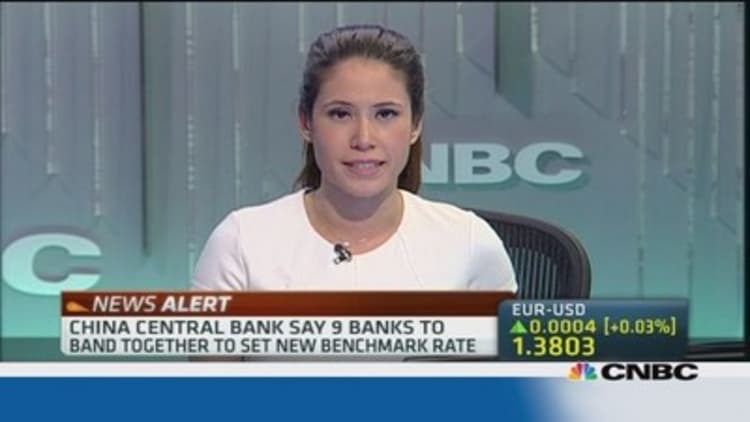
China launched a new benchmark lending rate on Friday in another step towards letting markets set the cost of funds and reducing distortions that have led to excessive investment and overcapacity now dogging the world's second-largest economy.
The "loan prime rate," will guide commercial bankers when setting interest rates when lending to their best customers, the country's central bank said.
The new rate, which only has a one-year tenor, was set by nine commercial banks including China's four biggest banks and was quoted for the first time on Friday at 5.71 percent.
(Read more: Why the huge write-off by China banks is positive)
China has been gradually moving away from rate controls in favor of a market-driven system and in July abolished all controls on bank lending rates.
However, it maintains a ceiling on deposit rates, seen as the most critical step Beijing needs to take to let market forces take over and introduce more competition to the banking sector, which is dominated by big state-owned institutions.
Friday's move shows the People's Bank of China (PBOC) wants to use the new benchmark as a non-binding and more market-based substitute for the official base rate for bank lending that was abolished together with lending rate limits, traders said.
"The loan prime rate is aimed at further promoting market-oriented interest rates, improving the benchmark rate systems and guiding the pricing of credit market products," the PBOC said in a statement published on its website.
The rate reform is part of a broad reform agenda China's new leadership is expected to outline at a key policy meeting next month, promising to steer the economy from its reliance on debt-fueled investment to a more balanced model driven more by consumption, services and innovation.
(Read more: China stocks sink after major banks write off debt)
"As the new benchmark is based on banks' lending to their best clients, it will actually serve as the floor for bank loans," said a trader at a Chinese commercial bank in Shanghai.
"It's another major step towards the liberalization of China's interest rate regime, but while it will grow to be a real benchmark in the longer term, the immediate impact will be limited as the market will watch how the new rate works."
While the central bank has been gradually laying the groundwork for a market-based system it has also used its day-to-day liquidity operations to rein in soaring credit and what it considered excessive risk taking.
After engineering a cash crunch in late June and letting funds flow back into the financial system in the following months, the central bank allowed cash to drain for two consecutive weeks, driving money rates to their highest since the June squeeze.
China launched the SHIBOR system in 2007 modeled after the London Interbank Offered Rate (LIBOR), hoping to develop it into China's benchmark rate system, though concerns over big influence of top banks have slowed the market's development.
(Read more: Agricultural Bank of China eyeing Wing Hang)
The SHIBOR is now based on quotes supplied from around 20 market makers for their lending to financial institutions in the interbank market and has been used in pricing debt issues.
But up to now China did not have a market-based benchmark for loans to corporate clients.
Economists have long identified China's financial system, where dominant state banks have been taking advantage of controls to secure cheap funds and funnel them to big state-owned enterprises, as one of key factors behind imbalances that have accumulated during three decades of breakneck growth.
The rate will be announced every working day by China's Shanghai-based interbank market and supplement the existing Shanghai Interbank Offered Rate (SHIBOR), the statement said.
The banks involved in quoting the rate are: Industrial and Commercial Bank of China(ICBC), China Construction Bank, Agricultural Bank of China, Bank Of China, Bank of Communications (BoCom), Citic Bank, Shanghai Pudong Development Bank, China Merchants Bank and Industrial Bank.

